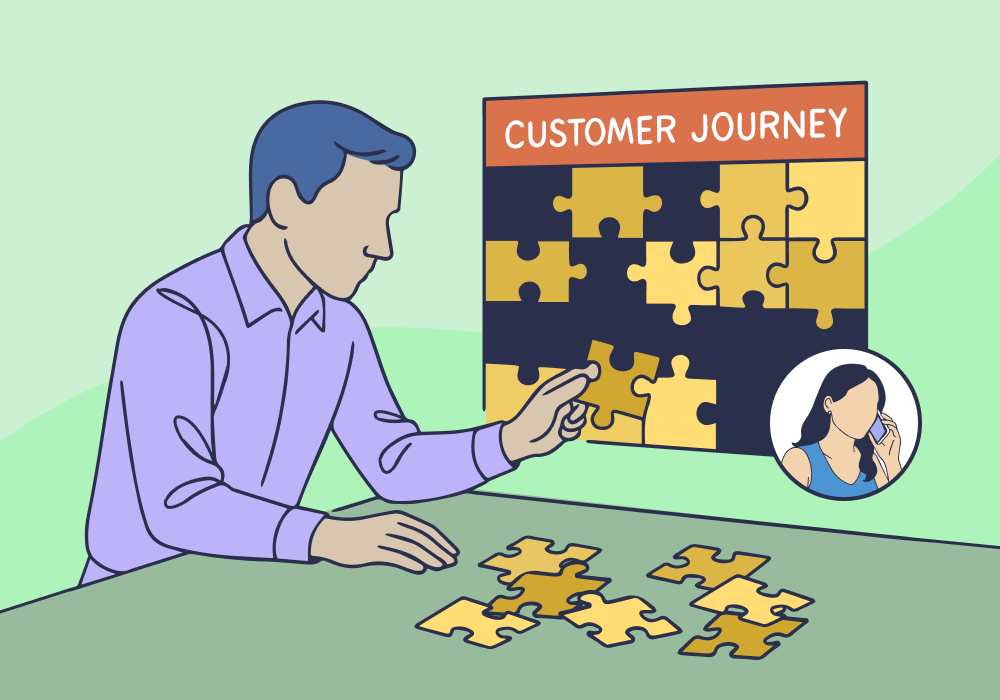
Marketing attribution is supposed to answer one simple question: what drove this conversion? If only it were that easy.
The real problem isn’t identifying a single touchpoint. It’s seeing every touchpoint that influenced the lead, because most customer journeys look nothing like a straight line.
A prospect clicks a Google ad and leaves. Two days later, they see a Meta ad and browse again. A week passes—they Google your client’s name, read a service page, and call.
Which touchpoint gets the credit? The last click? The first click? Neither answer helps you optimize what actually drove results.
And this is where most marketers lose money.
Most tools only capture pieces of the journey: Google Ads sees the click, call tracking logs the call, Analytics records the session. Each tool sees its slice, while the full story stays invisible.
That invisibility is the real blind spot: You can’t optimize what you can’t see.
The Blind Spot: Missing Touchpoints = Misguided Decisions
Most marketers optimize based on the platform’s reported “conversion source.”
But most conversions don’t happen after a single touchpoint. Here’s a typical journey:
- Someone discovers your client through a Meta ad.
- They return through a Google search ad.
- They browse, leave, then come back through organic search.
- Finally, they pick up the phone and call.
On paper: Google Ads gets full credit, Meta looks like it did nothing, and organic pops up as a surprisingly strong closer.
In reality: Meta did the heavy lifting to create the demand, Google harvested the lead, and organic closed the deal.
Without visibility across every step, early influence disappears—and your optimization decisions tilt toward whatever touchpoint happened last.
That’s the blind spot draining budget and punishing your most important channels.
The Results: Good Campaigns Get Cut, Bad Campaigns Get More Budget
When journeys become invisible, marketers unintentionally optimize in the wrong direction.
- Assisting channels get cut because they show “no conversions.”
- Last-click channels get overfunded even if they don’t drive revenue.
- Great campaigns get paused because they “look expensive.”
- Cheap, low-value campaigns get rewarded because they appear efficient.
This leads to the worst case scenario for agencies:
Good marketing looks bad, bad marketing looks good, and clients lose confidence in the data—and in you.
Why Stitching Together Multiple Tools Doesn’t Fix It
Most teams try to reconstruct a journey by connecting call tracking, forms, CRM records, and analytics.
That’s a puzzle you can piece together, at least in theory. In practice, the puzzle fights back:
- Each tool uses different identifiers. Mobile-to-desktop journeys break instantly.
- Data lives in silos. Every platform has its own dashboard, logic, and export format.
- Manual reconciliation is slow. By the time you spot a pattern, the moment to act has passed.
The DIY approach is possible. It’s just not scalable or accurate for real optimization.
How Full Journey Visibility Changes Everything
When you track every touchpoint on a single journey—ads, keywords, pages, calls, forms, chats, emails, and revenue—patterns start to appear that you could never see before:
- Meta campaigns with “zero conversions” turn out to drive your most valuable assisted leads.
- “Low-volume” search campaigns turn out to have the highest lead value.
- Certain landing pages influence almost every closed deal.
Full visibility reveals which touchpoints actually matter (and which ones simply look good on last-click reports).
Unified Tracking Fixes the Blind Spot
Here’s what solving the problem looks like in practice:
- Every lead is captured, no matter where it starts
- Every touchpoint is stitched together, forming a complete customer journey
- Every conversion is mapped back to the true source, not the last one
- Every lead is scored and valued, so you can optimize for revenue—not just volume
- Every platform (Google, Meta, etc.) gets the right signals, improving automated bidding and reducing wasted spend
When you combine journey visibility with lead value, suddenly your optimization decisions become obvious.
Campaigns you thought were weak turn out to be your strongest profit engines, and campaigns you thought were stars turn out to be empty-calorie traffic.
Where WhatConverts Fits In
WhatConverts was built to eliminate journey blind spots.
We capture every lead and every touchpoint, then connect them to actual lead value—all in one platform. That means you can:
- See the full journey from first click to final call.
- Attribute revenue to the real source—not the last source.
- Identify assist channels that quietly drive your best customers.
- Qualify and value leads automatically with AI.
- Send lead value back to Google and Meta so automated bidding optimizes for profit.
Unlike CRMs and analytics tools, WhatConverts shows the marketing story at the individual lead level—not just aggregated conversions.
Proof: How Orbit Local Used Journey Visibility to Triple Client Growth
Orbit Local had a common problem: clients invested in multiple channels, but results appeared inconsistent and hard to justify.
After implementing WhatConverts, the picture changed fast:
- Every lead’s full journey was captured across calls, forms, and chats.
- The team could finally show clients how top-of-funnel activity influenced high-value conversions.
- Meta campaigns previously listed as “no conversions” were revealed as major assist drivers.
- Optimization decisions shifted from “what looks cheap” to “what drives revenue.”
The result:
- 3× client base growth with the same team size
- Faster optimization; no more guessing
- Stronger client confidence and longer retention
When you show clients the real path from click to revenue—touchpoint by touchpoint—the conversation shifts from defense to growth.
When You Remove the Blind Spot, Better Decisions Become Inevitable
Marketing becomes a guessing game when you only see the last step a customer takes.
Full journey visibility turns:
- “I think” into “I know.”
- Unproven assumptions into clear insights.
- Decisions based on cost-per-lead into decisions based on revenue.
- Confusing dashboards into a single clear story.
You can’t optimize what you can’t see. But once you see the full journey, your best channels finally get the credit—and the budget—they deserve.
Ready to get a full view into your lead journey?
Start your free 14-day trial of WhatConverts today or book a demo with a product expert to see how we help prove and grow your ROI.
Get a FREE presentation of WhatConverts
One of our marketing experts will give you a full presentation of how WhatConverts can help you grow your business.
Schedule a Demo
Grow your business with WhatConverts





